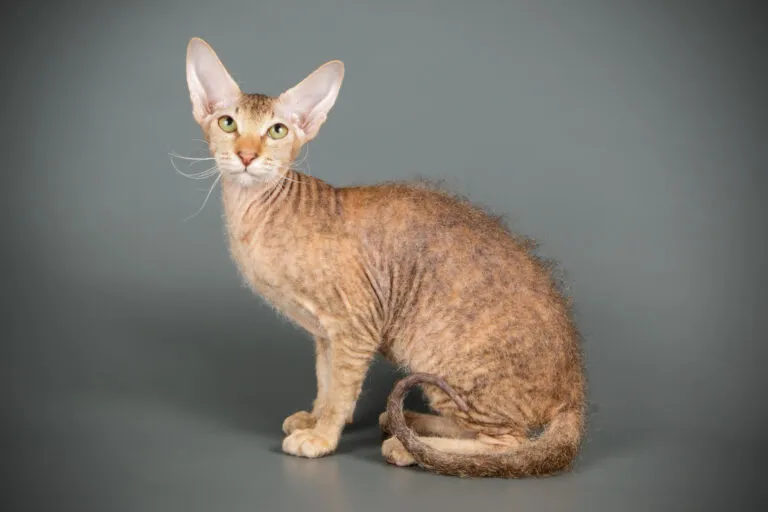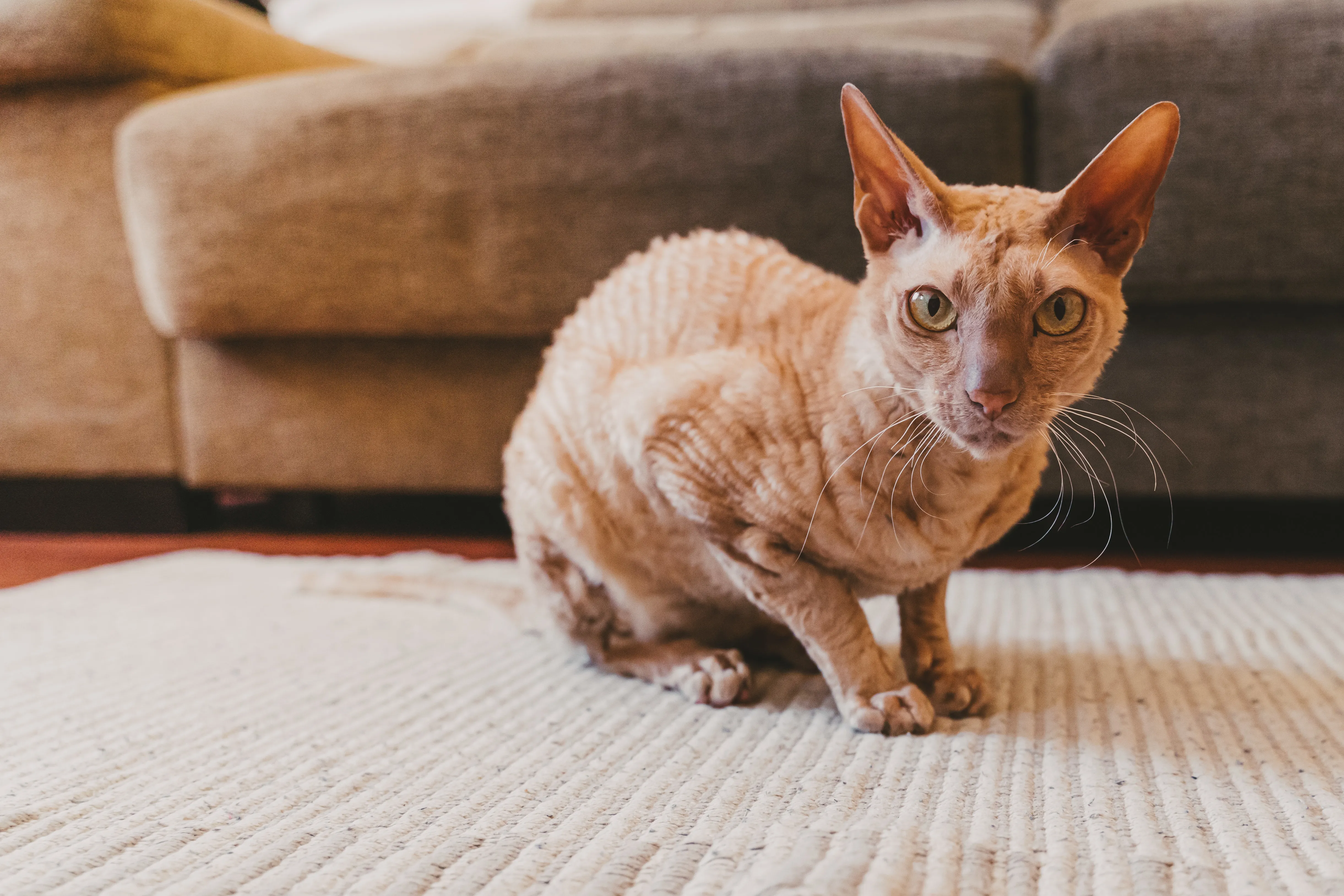Maine Coon
The Maine Coon has become one of the most popular cat breeds in the world. This is probably due to its majestic appearance, robust nature and great character.
Furless cats trigger very different reactions. But the Peterbald, a cat breed also found in a hairless variety, cares little about this: with its friendly nature, it effortlessly wins over cat lovers across the world.

© Aleksand Volchanskiy / stock.adobe.com
The elegance of the Peterbald is striking along with its unique fur: it has long legs and a slender, athletic body. As a medium-sized cat, it weighs between 3 and 4kg. Like all oriental cats, the Peterbald has a long triangular snout, flat cheekbones and long, well-separated ears. Its eyes are large and almond-shaped.
Although this breed from St Petersburg has the word ‘bald’ in its name, the name doesn’t say it all, because the Peterbald can be found with several varieties of fur:
The Sphynx is the most famous hairless cat, but a cat breed called the Peterbald has been conquering the hearts of hairless cat fans for two centuries in Russia. Peterbald cats were invented in 1994 in St Petersburg, where a scientist crossed a female Oriental Shorthair with a male Don Sphynx. The Don Sphynx is a Russian hairless cat, which despite its name isn’t related to the more famous Sphynx breed. Four Peterbalds resulted from two of these pairings and thus the well-known founders of the new breed: Mandarin iz Murino, Muscat iz Murino, Nezhenka iz Murino and Nocturne iz Murino. Just two years later, the Russian cat association SFF recognised the breed’s independence. The large umbrella association TICA followed suit in 1997. The World Cat Federation didn’t accept the Peterbald as an independent breed until 2006. It is currently only ‘provisionally accepted’ by the FiFé.
In order to expand the gene pool and combine the desired appearance of a hairless cat with the physique of oriental cat breeds, it is permitted to cross Siamese and Burmese cats. Until 2005, breeders were allowed to cross semi-longhaired Javanese and Balinese cats to form the Peterbald.
If you’re considering taking a Peterbald into your home, you should prepare for a bundle of energy. If they get sufficient activity and space, they spread positive vibes. They generally get on fantastically with fellow cats and other animals. The Peterbald even likes children, as long as they are used to treating animals with respect. These cats are happiest in close proximity to their owner, with whom they like to ‘speak’ loudly – typically of oriental cats. However, they are less chatty than the Siamese, for instance.
The Peterbald needs plenty of space and activity. We often read that they are only suitable for being kept in an apartment. However, they can enjoy outdoor access, ideally in a secured garden or balcony. If you solely wish to keep your Peterbald in your home, you should offer it plenty of space. You can make a home bigger for a cat with little tricks. For instance, you can create a type of catwalk with scratching trees and boards on the wall and give your Peterbald more room to discover, walk and observe. Another key point is that the Peterbald needs fellow cats in order to feel happy. Hence, it should always be kept with at least one other cat.
In terms of temperament, the Peterbald can be socialised well with other oriental cats. Fresh air fanatics should be aware that the temperature at which cats from this breed with very fine hair or none at all feel at ease is subject to controversial discussion. Some Peterbald owners recommend a room temperature of at least 22ºC throughout the day, which can have a severe impact on the heating bill in the winter months. In contrast, others are of the opinion that the Peterbald feels just as at ease at 18ºC.
The Peterbald needs a protein-rich diet. Regardless of whether it’s wet or dry food, meat should be at the top of the ingredients list. Dry food can fill intelligence toys, as a treat or for search games. However, it isn’t recommended to offer the Peterbald unlimited dry food throughout the day. If you wish to give your cat a BARF diet with raw meat, you should read up on this beforehand. BARF additives tailored to cats make this diet easier. If you wish to feed raw meat now and again, up to 20% of the food can be made up of raw meat without having to resort to supplements. Nevertheless, avoid pork as it could contain Aujeszky’s disease, which is dangerous for cats. Hairless Peterbald varieties in particular tend to burn more calories: their daily portions are allowed to be slightly bigger as long as the cat doesn’t gain weight.
Freeze-dried snacks make suitable snacks, as well as other treats – ideally free of sugar and grain. Provide enough fresh water for your cat. A drinking fountain encourages many cats to consume additional fluids.
 © Victoria / stock.adobe.com
© Victoria / stock.adobe.com
Responsible breeders test the animals they use for breeding for common hereditary diseases, therefore their kittens will most likely be healthy. For instance, the parent animals undergo an annual ultrasound scan up to the age of five years for the hereditary cardiac disease HCM. A genetic test for the ocular disease progressive retina atrophy (PRA) is now one of the standard tests. The most important building block for a healthy Peterbald is buying from a responsible breeder. However, there is still a problematic aspect. The laws of some countries class cats bred without whiskers as torture breeding – more on this later.
With or without hair, grooming is very simple – even with the short-haired variety, it’s sufficient to occasionally stroke it with a massage glove. By doing so, you remove dead hairs and reinforce your connection with your cat. With good health and grooming, a Peterbald can live to be 15 years of age or older.
Do cats with little or no coat catch colds more often? Presumably Peterbalds are more sensitive to the cold. Light-skinned specimens in particular have to be protected from direct sunlight. Otherwise, they face the danger of sunburn. Some Peterbalds with outdoor access in the garden or on the balcony like to get used to a type of cat coat that protects them from the cold. If you observe your Peterbald, you will soon find out if it is cold. In any case, your cat should have access to a warm spot at all times.
Many are critical of the lack of whiskers with completely bald Peterbald cats, as this means a significant loss of orientation. In addition, it is forbidden to breed cats without whiskers in some countries as this can fall under what is known as torture breeding. Some court decisions in relation to the Sphynx cat have confirmed this. If you want a Peterbald, speak to the potential breeder about their view on this subject. Some breeders set great store by breeding Peterbalds with whiskers.
We now know that some Peterbald cats have fur. Neither they nor the bald variety are unconditionally suitable for allergy sufferers, because they react to an enzyme in the cat’s saliva. If they have a severe allergy, this can emerge with hairless cats too, as cats spread their saliva on the skin. If in doubt, talk to your GP or dermatologist about your plan to take a cat into your home.
The Peterbald is a rare cat breed in Europe. If you’re looking for a hairless cat, it will be easier to find a Sphynx. If it’s the physique and character that matter to you, oriental cats like the Siamese or Oriental Shorthair are a good alternative. However, the combination of an oriental cat with little fur can only be found in the Peterbald and you should take time to find a responsible breeder. Some have waiting lists that you can sign up to if you’re interested. When purchasing a kitten, choose a breeder who can provide official paperwork from a reputable association. Steer clear of dubious small ads. The Peterbald is a young breed and some people profit from its exclusivity. For instance, they sell pairings of Sphynx cats without the correct paperwork with random oriental cats as a so-called Peterbald.
All reputable breeders belong to an association and sell their cats with the required paperwork. Discuss healthcare provision with the breeder and be happy if they ask you a few questions about your living situation and experience with cats. This shows that the wellbeing of the cat is important to them. Young kittens will be yours from the age of around 13 weeks. They should come with the correct paperwork and a vaccination certificate. Make sure you keep up with booster vaccinations.
If you wish to take an adult cat from an animal shelter into your home, it will be very hard to find a Peterbald. On rare occasions, breeders give away castrated cats that they can no longer use for breeding. However, it’s more likely that you will come across older Sphynx cats or hybrids. Approach the search with an open mind – this way you will the right cat for you regardless of breed!
We wish you plenty of joy with your lively Peterbald!
The Maine Coon has become one of the most popular cat breeds in the world. This is probably due to its majestic appearance, robust nature and great character.
Large eyes and attentively upright ears instantly tell you a great deal about this charming breed of cat: Abyssinians are inquisitive and affectionate towards people.
With its long, dense fur, rounded ears, and intense stare, the Pallas Cat, or Manul, looks rather fluffy, yet somewhat dangerous. However, don't be fooled by its appearance—this is no petting zoo resident. The Manul is a wild animal and considered untameable.